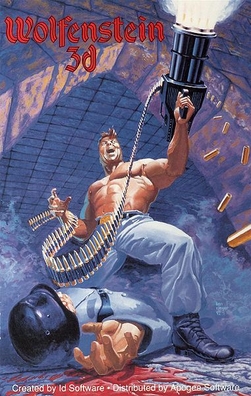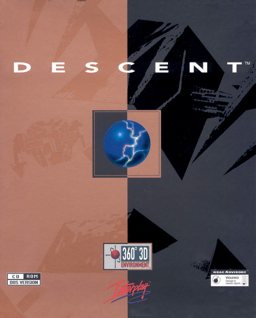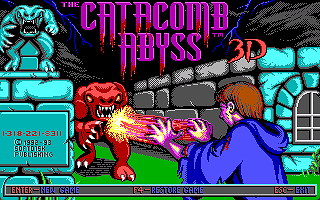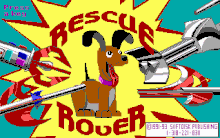
id Software LLC is an American video game developer based in Richardson, Texas. It was founded on February 1, 1991, by four members of the computer company Softdisk: programmers John Carmack and John Romero, game designer Tom Hall, and artist Adrian Carmack.

Quake is a first-person shooter game developed by id Software and published by GT Interactive. The first game in the Quake series, it was originally released for MS-DOS, Microsoft Windows and Linux in 1996, followed by Mac OS and Sega Saturn in 1997 and Nintendo 64 in 1998. In the game, players must find their way through various maze-like, medieval environments while battling monsters using an array of weaponry. Quake takes inspiration from gothic fiction and the works of H. P. Lovecraft.

Wolfenstein 3D is a first-person shooter video game developed by id Software and published by Apogee Software and FormGen. Originally released on May 5, 1992, for DOS, it was inspired by the 1981 Muse Software video game Castle Wolfenstein, and is the third installment in the Wolfenstein series. In Wolfenstein 3D, the player assumes the role of Allied spy William "B.J." Blazkowicz during World War II as he escapes from the Nazi German prison Castle Wolfenstein and carries out a series of crucial missions against the Nazis. The player traverses each of the game's levels to find an elevator to the next level or kill a final boss, fighting Nazi soldiers, dogs, and other enemies with a knife and a variety of guns.
Commander Keen is a series of side-scrolling platform video games developed primarily by id Software. The series consists of six main episodes, a "lost" episode, and a final game; all but the final game were released for MS-DOS in 1990 and 1991, while the 2001 Commander Keen was released for the Game Boy Color. The series follows the eponymous Commander Keen, the secret identity of the eight-year-old genius Billy Blaze, as he defends the Earth and the galaxy from alien threats with his homemade spaceship, rayguns, and pogo stick. The first three episodes were developed by Ideas from the Deep, the precursor to id, and published by Apogee Software as the shareware title Commander Keen in Invasion of the Vorticons; the "lost" episode 3.5 Commander Keen in Keen Dreams was developed by id and published as a retail title by Softdisk; episodes four and five were released by Apogee as the shareware Commander Keen in Goodbye, Galaxy; and the simultaneously developed episode six was published in retail by FormGen as Commander Keen in Aliens Ate My Babysitter. Ten years later, an homage and sequel to the series was developed by David A. Palmer Productions and published by Activision as Commander Keen. Another game was announced in 2019 as under development by ZeniMax Online Studios, but was not released.

John D. Carmack II is an American computer programmer and video game developer. He co-founded the video game company id Software and was the lead programmer of its 1990s games Commander Keen, Wolfenstein 3D, Doom, Quake, and their sequels. Carmack made innovations in 3D computer graphics, such as his Carmack's Reverse algorithm for shadow volumes.

Descent is a first-person shooter (FPS) game developed by Parallax Software and released by Interplay Productions in 1995 for MS-DOS, and later for Macintosh, PlayStation, and RISC OS. It popularized a subgenre of FPS games employing six degrees of freedom and was the first FPS to feature entirely true-3D graphics. The player is cast as a mercenary hired to eliminate the threat of a mysterious extraterrestrial computer virus infecting off-world mining robots. In a series of mines throughout the Solar System, the protagonist pilots a spaceship and must locate and destroy the mine's power reactor and escape before being caught in the mine's self-destruction, defeating opposing robots along the way. Players can play online and compete in either deathmatches or cooperate to take on the robots.

Hovertank 3D, also known under a variety of other names, is a vehicular combat game developed by id Software and published by Softdisk in April 1991.

Catacomb 3-D is a first-person shooter video game, the third in the Catacomb series, the first of which to feature 3D computer graphics. It was developed by id Software and originally published by Softdisk under the Gamer's Edge label, released in November 1991. The player takes control of the high wizard Petton Everhail, descending into the catacombs of the Towne Cemetery to defeat the evil lich Nemesis and rescue his friend Grelminar.

Doom II, also known as Doom II: Hell on Earth, is a first-person shooter game in the Doom franchise developed by id Software. It was released for MS-DOS in 1994 and Macintosh in 1995. Unlike the original Doom, which was initially only available through shareware and mail order, Doom II was sold in stores.

Softdisk was a software and Internet company based in Shreveport, Louisiana. Founded in 1981, its original products were disk magazines. It was affiliated and partly owned by paper magazine Softalk at founding, but survived its demise.
Doom, a first-person shooter game by id Software, was released in December 1993 and is considered one of the most significant and influential video games in history. Development began in November 1992, with programmers John Carmack and John Romero, artists Adrian Carmack and Kevin Cloud, and designer Tom Hall. Late in development, Hall was replaced by Sandy Petersen and programmer Dave Taylor joined. The music and sound effects were created by Bobby Prince.

Doom 64 is a first-person shooter game by Midway. It was first released for the Nintendo 64 in 1997, as the second spin-off game in the Doom series after Final Doom (1996), and the fourth game in the series overall. A remastered port was developed by Nightdive Studios and published by Bethesda Softworks for Nintendo Switch, PlayStation 4, Windows, and Xbox One in March 2020, and for Stadia in May 2020.

Catacomb Abyss is a fantasy themed first-person shooter (FPS) game developed by Softdisk and released in November 1992 for MS-DOS. It is the fourth entry in the Catacomb series of video games. Its predecessor, Catacomb 3-D, was developed by id Software as part of a contract with Softdisk. When the contract ended, Softdisk kept ownership of both the 3D engine as well as the intellectual property of Catacomb 3-D. The company formed a new, in-house team to develop three sequels, known as the Catacomb Adventure Series. This trilogy consists of Catacomb Abyss, Catacomb Armageddon and Catacomb Apocalypse. Softdisk published a shareware version of Catacomb Abyss, which could be freely distributed and played to encourage gamers to purchase the full trilogy.

Commander Keen in Keen Dreams is a side-scrolling platform video game developed by id Software and published by Softdisk in 1991 for DOS. It is the fourth episode of the Commander Keen series. The game follows the titular Commander Keen, an eight-year-old child genius, in an adventure in his dreams as he journeys through a vegetable kingdom to defeat the evil potato king Boobus Tuber and free enslaved children from the Dream machine. The game features Keen running and jumping through various levels while opposed by various vegetable enemies; unlike the prior three episodes, Keen does not use a pogo stick to jump higher, and throws flower power pellets to temporarily turn enemies into flowers rather than shooting a raygun to kill them.

Commander Keen is a side-scrolling platform video game developed by David A. Palmer Productions and published by Activision in June 2001 for the Game Boy Color. Part of the Commander Keen series, it was released ten years after the first seven episodes in 1990–91. The game follows the titular Commander Keen, an eight-year-old child genius, as he journeys through three alien worlds to collect three plasma crystals to prevent the weapon they power, built by several enemies from previous games, from destroying the universe. The game features Keen running, jumping, and shooting through various levels while opposed by aliens, robots, and other hazards.
Adaptive tile refresh is a computer graphics technique for side-scrolling video games. It was most famously used by id Software's John Carmack in games such as Commander Keen to compensate for the poor graphics performance of PCs in the early 1990s. Its principal innovation is a novel use of several EGA hardware features to perform the scrolling in hardware. The technique is named for its other aspect, the tracking of moved graphical elements in order to minimize the amount of redrawing required in every frame. Together, the combination saves the processing time that would be otherwise required for redrawing the entire screen. Carmack designed the software engine based on a scrolling display for large images from the 1970s.

Commander Keen in Invasion of the Vorticons is a three-part episodic side-scrolling platform video game developed by Ideas from the Deep and published by Apogee Software in 1990 for MS-DOS. It is the first set of episodes of the Commander Keen series. The game follows the titular Commander Keen, an eight-year-old child genius, as he retrieves the stolen parts of his spaceship from the cities of Mars, prevents a recently arrived alien mothership from destroying landmarks on Earth, and hunts down the leader of the aliens, the Grand Intellect, on the alien home planet. The three episodes feature Keen running, jumping, and shooting through various levels while opposed by aliens, robots, and other hazards.

Commander Keen in Goodbye, Galaxy is a two-part episodic side-scrolling platform video game developed by id Software and published by Apogee Software in 1991 for DOS. It consists of the fifth and sixth episodes of the Commander Keen series, though they are numbered as the fourth and fifth, as Commander Keen in Keen Dreams is not part of the main continuity. The game follows the titular Commander Keen, an eight-year-old child genius, as he first journeys through the Shadowlands to rescue the Gnosticenes so they may ask the Oracle how the Shikadi plan to destroy the galaxy, and then through the Shikadi's Armageddon Machine to stop them. The two episodes feature Keen running, jumping, and shooting through various levels while opposed by aliens, robots, and other hazards.

Commander Keen in Aliens Ate My Babysitter is a side-scrolling platform video game developed by id Software and published by FormGen in December 1991 for DOS. It is the seventh episode of the Commander Keen series, though it is numbered as the sixth, as Commander Keen in Keen Dreams is outside of the main continuity. The game follows the titular Commander Keen, an eight-year-old child genius, as he journeys through an alien world to rescue his kidnapped babysitter. The game features Keen running, jumping, and shooting through various levels while opposed by aliens, robots, and other hazards.
















